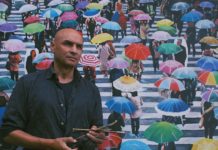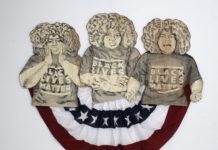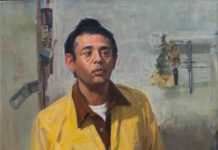Booth Gallery welcomes Mexican painter Horacio Quiroz to NYC for his debut solo exhibition in the United States, “Polarities.” The following is our exclusive, bilingual interview on the development of Quiroz’s unique style, his medium of choice, and what he hopes viewers take away from his art.

Cherie Dawn Haas: Please tell us about your paintings. Do you refer to them as portraits? As surreal? How would you describe your work to someone who has not yet seen it?
Horacio Quiroz: During the creation process I don’t think of them as portraits, but the final results would suggest they are. I believe the individuals that take shape in my paintings are rather personalities, since they are created from various references, photographs, drawings, or sketches, until they acquire their final shape on canvas.
The style is pop surrealism or lowbrow, to situate it somewhere. Although in my case, the fledgling work gestates without thinking about where or how my work fits within particular artistic styles.
I would describe my work as painting that speaks to the human condition, utilizing the human body as a tool to represent movement and flux. Change is the only constant and we, as human beings, are part of this continuous flow.
Durante el proceso de creación yo no pienso en ellos como retratos, pero el resultado final lo sugiere de esa forma. Creo para mi los individuos que toman forma en mis pinturas son más bien personajes, ya que son creados a través de distintas referencias, fotografías, dibujos o bocetos hasta que adquieren la forma final en el lienzo.
El estilo es surrealista pop o lowbrow, por situarlo dentro de un lugar, aunque para mi la creación pictórica se gesta sin pensar en donde o como encaja mi obra dentro de los estilos artísticos.
Describo mi trabajo como una pintura que habla de la condición humana utilizando el cuerpo humano como herramienta para representar el movimiento y el cambio. El cambio es la única constante y nosotros como seres humanos somos parte de este continuo fluir.

CDH: How has your work evolved over time? Or, how did you develop this style?
HQ: My style simply came about; it wasn’t conceptualized. I can’t give you some rational explanation of how it emerged. What I can tell you is that when I began my career as a painter, I was weighed down by years of frustration and career dissatisfaction. So when I decided to change my profession and dedicate myself to art, painting functioned as a catharsis representing the internal exploration of my psychological processes.
Yes, I think my style has evolved over the years I’ve been painting. Compared to the past, the color palette is much more varied, the compositions are more complicated, and the aesthetic, although still surrealistic, is less grotesque or obscure. My work has always been a reflection of my emotional situation and the evolution can obviously be attributed to that.
Mi estilo simplemente sucedió, no fue preconcebido. No puedo darte alguna explicación racional de cómo surgió. Lo que te puedo decir es que cuando empecé mi carrera como pintor venía arrastrando años de frustración y descontento laboral así que cuando decidí cambiar de profesión y dedicarme al arte, la pintura funcionó como catarsis para representar la exploración interna de mis procesos psicológicos.
Si, creo que mi estilo ha ido cambiando durante los años que llevo pintando. Ahora en comparación al pasado la paleta de colores es mucho más variada, las composiciones son más complicadas y la estética aunque sigue siendo surrealista aunque menos grotesca u obscura. Mi trabajo siempre ha sido reflejo de mi situación emocional y la evolución obviamente lo atribuyo a ello.

CDH: What is your preferred media, and why? What advice can you give to others just starting out with it?
HQ: I like oil, because of the versatility in its use and the vitality of its color. My advice is to not be afraid to paint with oil; it is a very noble material.
Me gusta el óleo por la versatilidad en su uso y el brillo en su color. Mi consejo es no tener miedo de pintar con aceite; es un material muy noble.

CDH: What do you hope others take away from your art?
HQ: “Boys should not cry, they should always be strong!
Girls should not get angry, they should always be good!”
We have grown up with these terrible ideas rattling around inside our heads, making it a prison of our own emotions. Society moulds us to not show what we feel, to not show vulnerability and to pretend that we are always fine. I would love for whoever sees any of my pieces to be able to be affected, however that may provoke them, and that they can then connect with that emotion. Simply, that they feel something.
”Los niños no deben llorar, siempre deben ser fuertes. Las niñas no deben enojarse, siempre deben ser buenas.” Hemos crecido pensando estas ideas terribles en la cabeza volviéndonos cárcel de nuestras propias emociones. La sociedad nos moldea para no mostrar lo que sentimos, no mostrar vulnerabilidad y pretender que siempre estamos bien. Me encantaría que quien vea alguna pieza mía se permita sentir, lo que sea que esta le provoque y que pueda conectar con ese sentimiento. Solo eso, sentir algo.



“Polarities” is on view through October 20, 2018, at Booth Gallery (NYC). For more information, please visit www.paulboothgallery.com.





Yes, this work shows how very horribly people can be affected by awful experiences of keeping emotions locked inside. But that paintings depicting this are the continuing work of the artist, is sad. Now that he has expressed this terribleness, perhaps he would be willing to make paintings that show the beauty of humanity. God bless, C-Marie
Comments are closed.